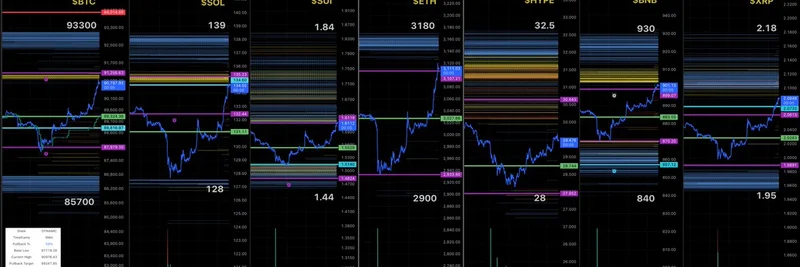Hey there, blockchain enthusiasts! If you're into decentralized finance (DeFi), you know how fast things move in this space. Drawing from a recent update by DeFi expert @Defi0xJeff, we're seeing vibes reminiscent of the legendary DeFi summer—but this time with smarter, more innovative products. Let's break down the key happenings this week, explaining the jargon along the way so everyone can follow.
Plasma Emerges as a Liquidity Powerhouse
Plasma (@Plasma) has been turning heads as a "liquidity hole," pulling in massive capital with stable farming opportunities offering 30-100% APY (annual percentage yield—that's the return you can expect on your staked assets over a year). These high yields are boosted by generous incentives in their native token, XPL. This surge isn't just hype; it's driving real growth in the ecosystem.
As a result, lending protocols like Aave (@aave) and Fluid (@0xfluid) have seen their TVL (total value locked, basically the amount of assets deposited in the protocol) skyrocket. If you're farming yields, this is a prime spot to park your stablecoins without too much risk.
DeFi Meets AI: ZyfAI's Plasma Integration Sparks a Rally
One of the most exciting crossovers? ZyfAI (@ZyfAI_) integrated with Plasma, leading to a quick 2x pump in its token price within a day. This shows how DeFi and AI are starting to blend—DeFi provides the financial rails, while AI adds smart automation. For meme token traders, this kind of integration could mean more efficient liquidity pools and automated strategies, potentially supercharging community-driven assets.
Pendle's Rollercoaster: TVL Dip but Record Volumes
Pendle (@pendle_fi) experienced a $6 billion drop in TVL due to a migration (shifting assets to a new version or chain), but don't count it out yet. It hit its highest daily trading volume ever at $805 million, and Q3 2025 was its best quarter with about $15.8 million in revenue. Pendle specializes in yield tokenization—think splitting future yields from principal for advanced trading strategies. This resilience highlights how mature DeFi protocols can bounce back stronger.
Boros Hits Major Milestones
In just two months, Boros (@boros_fi) reached $100 million in open interest (OI, the total value of outstanding derivative contracts) and $1.7 billion in trading volume. They're innovating with perpetual contracts (perps) focused on yield and funding rate trading, allowing users to bet on interest rate fluctuations without expiration dates. This could open new avenues for hedging in volatile markets, including those involving meme tokens.
Alchemix V3: Self-Repaying Loans on the Horizon
Alchemix (@AlchemixFi) is gearing up for its V3 launch, with audits nearly complete. The big draw? Efficient self-repaying loans, where your collateral generates yield to pay off the debt automatically. No more manual repayments—it's like borrowing against your future earnings in a decentralized way. This upgrade could make borrowing more accessible for everyday users and projects alike.
YieldBasis: Revolutionizing BTC Yields
From the founder of Curve, YieldBasis (@yieldbasis) lets users earn single-sided yields on Bitcoin (BTC) via a new automated market maker (AMM) design that eliminates impermanent loss (IL, the potential loss from price changes in liquidity pools). Their community round on Legion (@legiondotcc) with Kraken (@krakenfx) has seen over $70 million in oversubscription. For BTC holders tired of just HODLing, this could be a game-changer, and it ties into broader DeFi efficiency that benefits meme ecosystems by improving capital flow.
Andre Cronje's Flying Tulip: A Full-Stack DeFi Exchange
Andre Cronje (@AndreCronjeTech), a DeFi legend, is launching Flying Tulip—a comprehensive exchange covering spot trading, perps, yields, options, and lending/borrowing. What sets it apart is the unique fundraising and bootstrapping mechanism, detailed in this insightful piece by Lemniscap: Why Can AC's New Product Flying Tulip Be Valued at $1 Billion?.
In short, Flying Tulip targets a $1 billion valuation with a treasury invested in low-risk assets like US Treasuries, generating operational funds. Investors get FT tokens with a perpetual put option—redeem anytime at original price, making it deflationary as tokens are burned. This protects principal while funding development sustainably, avoiding the pitfalls of traditional token sales where values often crash.
Why This Matters for the Broader Blockchain Scene
These developments signal a DeFi renaissance, expanding categories like perps on yields (Boros), efficient borrowing (Alchemix V3), IL-free AMMs (YieldBasis), and grounded tokenomics (Flying Tulip's take on the old (3,3) model from OlympusDAO). Unlike the wild DeFi summer of 2020, today's innovations focus on real utility and capital efficiency.
For meme token communities, this means better tools for liquidity, yield farming, and trading—potentially leading to more sustainable pumps and community-driven growth. Keep an eye on these projects; they're paving the way for the next wave of blockchain adoption.
What do you think—ready for DeFi summer 2.0? Drop your thoughts in the comments!

